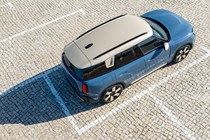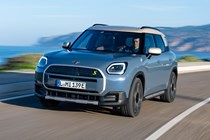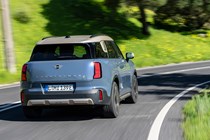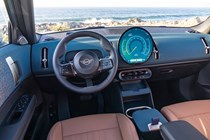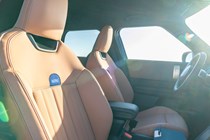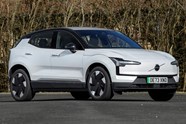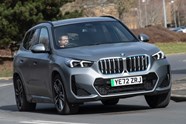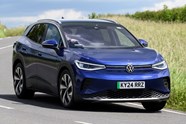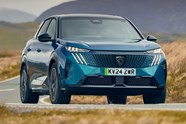MINI Electric Countryman review
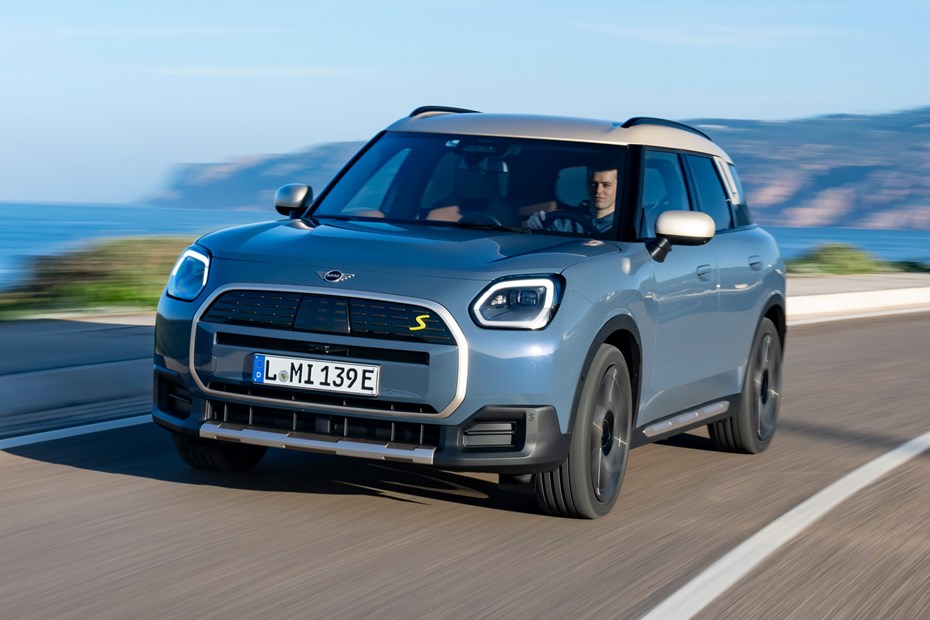
At a glance
| Price new | £33,005 - £48,005 |
|---|---|
| Used prices | £24,409 - £40,920 |
| Road tax cost | £195 - £620 |
| Insurance group | 23 - 32 |
Get an insurance quote with

|
|
| Fuel economy | 3.4 - 3.9 miles/kWh |
| Range | 252 - 287 miles |
| Miles per pound | 5.4 - 11.5 |
| Number of doors | 5 |
| View full specs for a specific version | |
Available fuel types
Fully electric
Pros & cons
- High quality electric drive system
- Stylish and practical
- Good to drive
- Still a premium over petrol
- Few physical interior buttons
- Not as practical as the petrol Countryman
MINI Electric Countryman SUV rivals
Overview
As well as being bigger and more practical than the previous version, the third-generation MINI Countryman is also the first to come as a 100% electric vehicle (EV). Is the new MINI Countryman Electric good enough to challenge for a place in our list of the best EVs? We’ve had an early drive of the range-topping SE ALL4 variant to find out.
This is a twin-motor model, meaning there’s an electric motor on the front and the back axle, delivering higher-performance as well as the added traction of all-wheel drive. With 313hp, it’s even more powerful than the top petrol model – which you can read about in our separate MINI Countryman JCW review.
More important for most buyers, we suspect, is that this electric MINI Countryman has a claimed driving range of 269 miles per charge – which is a competitive distance at this end of the EV market. A less powerful single-motor model, called the Countryman E, claims up to 287 miles.
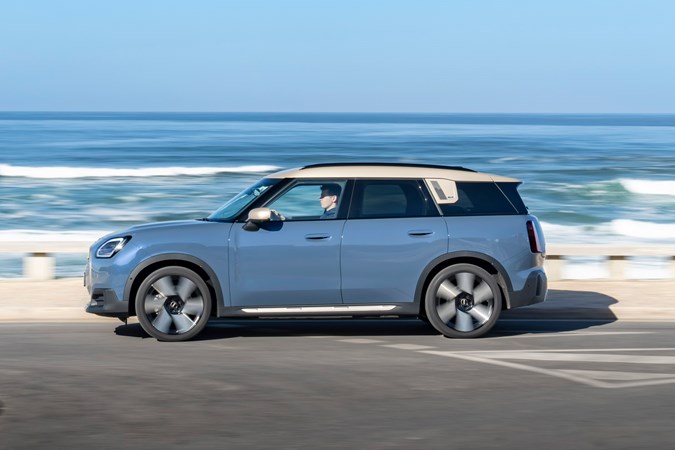
As a family friendly electric SUV, the Countyman has quite a few rivals to contend with. But few offer MINI’s blend of expressive style and fun driving experience. We’d suggest potential buyers also consider the Volvo EX30 and closely related Smart #1, while the Peugeot e-3008 is the probably best option from the Stellantis family of companies.
Prefer something a little more premium? Then there’s the BMW iX1, which has the same underlying platform and technology as this MINI EV but comes in what some would argue is a more grown-up package – though this is also reflected in its significantly higher price.
What’s it like inside?
There are no radical changes to the look of the cabin for the electric version of the MINI Countryman – but there are few special features. Most obvious are the artificial engine noises, which change depending on which ‘MINI Experience Mode’ you’ve got selected.
These are a little like driving modes, but they place more of an emphasis on varying the interior ambience than the way the car drives (though you can also adjust the steering weight and accelerator-response). The alterations come via differing infotainment graphics and interior lighting, including the ‘MINI Projector’ hidden behind the screen on the dashboard.

Like all third-gen MINI Countryman models, that infotainment screen is a circular OLED display that’s notable for its unique shape and the crispness of its graphics. It’s powered by MINI’s latest Operating System 9, which generally succeeds in being as easy to use as a smartphone. You can even download apps for video-streaming and gaming, to keep you entertained while charging.
What you won’t find are physical buttons for the climate control – and the touchscreen alternatives are among the most awkward we’ve used. Disappointing.
In better news, the novel knitted finish to the surfaces is made from recycled materials and comes in some interesting colour combinations. The seats are sustainably upholstered as well.
What’s more, the latest Countryman’s enlarged dimensions (it’s 6cm taller and 13cm longer) have turned it into a proper family SUV, with plenty of passenger space front and rear. Compared with the petrol version, the cabin floor is a little higher, so you lose a little foot and kneeroom in the back, but even this electric model has 460-1,450 litres of boot space.
MINI Countryman E electric motors
There are two electric versions of the MINI Countryman: the E and the SE ALL4.
So far, we’ve only been able to drive the SE ALL4. This is a dual-motor design, with the front and rear electric motors also giving it all-wheel drive. Maximum power output is 313ps with a chunky 494Nm of torque (pulling power). It’ll do 0-62mph in 5.6 seconds, and has an electronically limited top speed of 112mph.
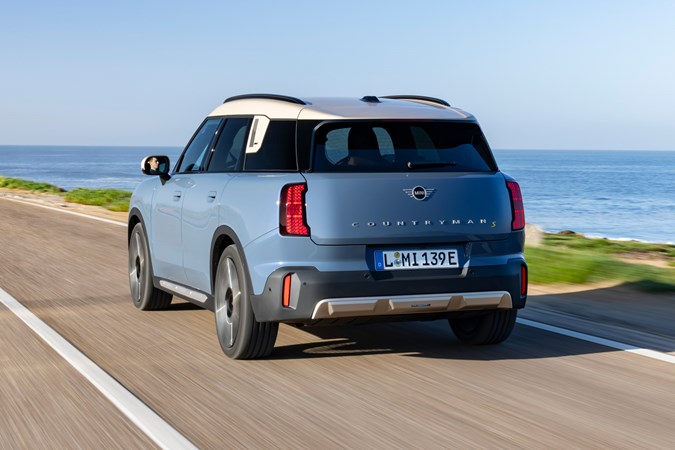
The cheaper Countryman E has just one motor, driving the front wheels only. This produces 204hp and 250Nm and does 0-62mph in 8.6 seconds. MINI isn’t currently saying anything about its top speed, but we expect it will be restricted to 105mph.
Reason being that every other stat for both motor variants exactly matches the performance of the equivalent BMW iX1 and BMW iX2, which use identical technical components.
All MINI Countryman models come with an automatic transmission as standard – in the case of the electric variants this is a single-speed gearset. In the SE ALL4’s case at least, this delivers swift, predictable responses, even at higher velocities where some electric vehicles start to become less eager.
Range and charging
Maximum quoted electric driving range for the MINI Countryman SE ALL4 is 269 miles per charge, while the MINI Countryman E does slightly better at 287 miles per charge.
Those are the official WLTP figures; we’d anticipate you’ll get around 30-50 miles less in the real world, depending on the time of year and how you’re driving, but BMW’s battery and electric drive technology – which MINI uses – is very good and may get closer to the claimed figures in some circumstances.
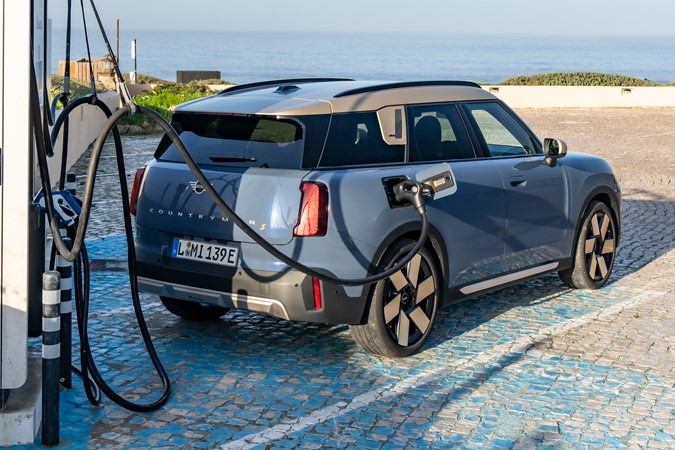
Both have the same 64.6kWh usable battery capacity, while charging options range from an onboard AC charger to 130kW DC fast charging. On a 7.4kW home wallbox – the most common type in the UK – you’ll need 10 hours for a full charge. A suitably powerful public DC fast charger promises 10-80% in 29 minutes, which isn’t bad at all by current standards.
What’s it like to drive?
This probably won’t come as a surprise to anyone who’s already made the transition to electric vehicles, but on the evidence of the driving we’ve been able to do so far – in both models – we prefer the electric MINI Countryman SE ALL4 to the performance-orientated John Cooper Works petrol variant.
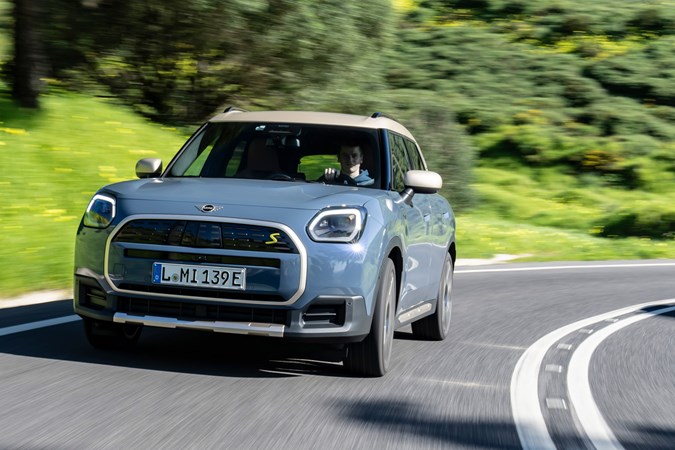
The 300hp JCW petrol model has slightly less power on paper but is also slightly faster, thanks to being considerably lighter without the need to lug a big battery back around. However, there’s very little in it and the instant response of the electric model will make up the difference in many circumstances – especially in cut and thrust traffic around town.
There’s not a vast amount of dynamic difference between the two, either. The JCW is a touch more agile, but both have all-wheel drive and quick steering, making it easy – and fun – to drive quickly on twisting roads.
However, the electric version is more comfortable and more refined. Replacing the occasionally coarse 2.0-litre petrol with a virtually silent electric drive system makes the Countryman perhaps a touch less exciting but certainly ups the sense of premium quality, cocooning you in a bubble of quiet that’s only interrupted by wind noise at very high speeds and road noise on poor surfaces; if you don’t like the virtual sounds that are piped into the cabin in place of an engine note they are easily switched off.
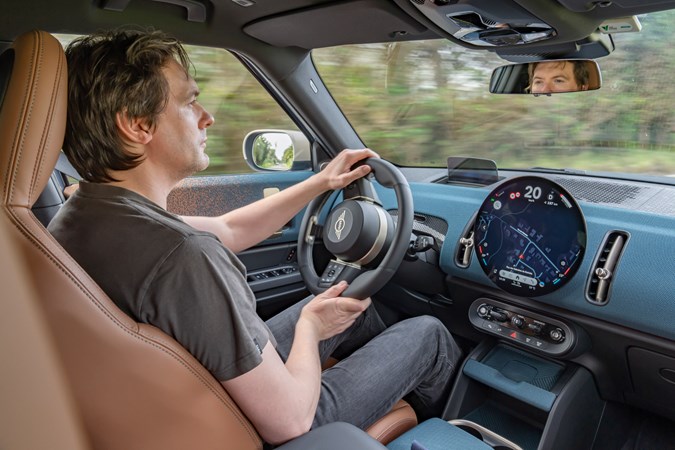
More significantly, the electric model has much better ride comfort, doing a far greater job of soaking up the sometimes very bumpy Portuguese tarmac of the launch test route. This probably isn’t a shock, as the JCW is deliberately intended to be a racy performance car, but since the Countryman Electric manages to do almost as good a job of being fun your spine seems an unnecessary sacrifice to make.
What models and trims are available?
Both electric models are available in a choice of Classic, Exclusive and Sport specifications.
Even the entry-level Classic is generously equipped – highlights include built-in satellite navigation (Apple CarPlay and Android Auto are also included), cruise control, heated steering wheel, dual-zone air-conditioning, LED headlights and i-Size child-seat mounting points on the front passenger seat as well as the two outer rear ones. Plus a host of active and passive safety equipment.
Upgrades for the Exclusive include changing from 17- to 18-inch alloy wheels, John Cooper Works seats (sportier, with greater support) and anthracite headlining. On the Sport you get 19-inch alloys, a further JCW interior makeover, and bigger JCW brakes.
Popular options are bundled into packs labelled Level 1 and Level 2. The first adds adaptive headlights, heated front seats, wireless phone charging and a head-up display – among other items – while the second includes all these plus a Harman Kardon hi-fi system, panoramic glass roof, windows with additional sunlight filtering and an increased roster of safety kit.
Anything else I should know?
Pricing for the electric Countryman starts at £42,080 for the 204hp single-motor E and £47,180 for the twin-motor 313hp SE ALL4. Might seem a lot, but for the EV performance and standard equipment you get it’s actually very competitive. Certainly makes the BMW iX1 – which starts at over £45,000 – look expensive, that’s for sure.




